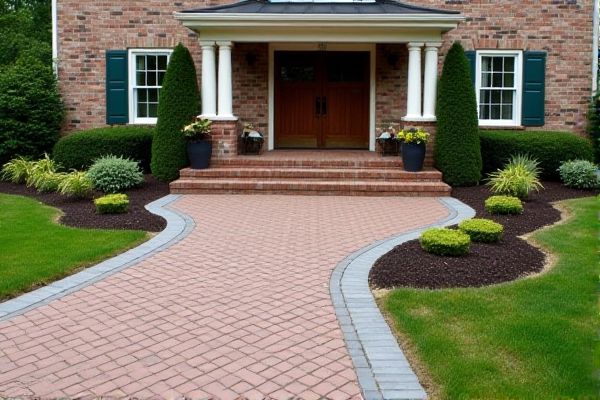
Brick pavers offer durability, easy maintenance, and a customizable, classic appearance ideal for walkways and patios, while stamped concrete provides a cost-effective way to mimic natural stone or brick with versatile design options. Explore the rest of the article to determine which option best suits your outdoor space and personal style.
Table of Comparison
| Feature | Brick Paver | Stamped Concrete |
|---|---|---|
| Material | Baked clay bricks | Concrete with stamped patterns |
| Durability | Highly durable, resistant to cracking | Durable but prone to cracking over time |
| Installation Cost | Higher due to labor-intensive process | Lower, faster installation |
| Maintenance | Requires periodic sealing and weed control | Needs resealing and crack repairs |
| Appearance | Traditional, classic brick look | Customizable patterns and colors |
| Slip Resistance | Natural slip resistance | Varies; can be slippery when wet |
| Repair | Easy to replace individual bricks | Repair can be costly and visible |
| Climate Suitability | Ideal for freeze-thaw climates | May crack in extreme temperature changes |
Introduction: Brick Paver vs Stamped Concrete
Brick pavers offer durability, natural texture, and easy maintenance, making them ideal for walkways and patios that require long-lasting appeal. Stamped concrete provides versatile design options with the ability to mimic stone, brick, or wood at a lower initial cost and faster installation time. Your choice depends on balancing the aesthetic preferences, budget, and longevity requirements for your outdoor space.
Aesthetic Appeal and Design Versatility
Brick pavers offer a classic, timeless aesthetic with a variety of colors and patterns that enhance design versatility for pathways, patios, and driveways. Stamped concrete provides the ability to mimic natural stone, brick, or slate, delivering a seamless and customizable surface with intricate textures and color options. Both materials allow for unique landscaping designs, but brick pavers are better suited for projects requiring easy repairs and high durability.
Installation Process Overview
Brick paver installation involves laying individual bricks on a compacted base with sand, requiring precision in alignment and joint filling for stability. Stamped concrete is poured as a single slab, then textured and colored before setting, offering faster installation but demanding careful curing to prevent cracks. Both methods require proper base preparation to ensure durability and performance under various weather conditions.
Durability and Longevity Comparison
Brick pavers offer superior durability and longevity due to their ability to withstand heavy loads, resist cracking, and easily replace damaged units, often lasting over 30 years with minimal maintenance. Stamped concrete, while visually appealing and initially cost-effective, tends to develop cracks over time from weather exposure and ground movement, typically requiring resurfacing or repairs every 10-15 years. The interlocking nature of brick pavers also allows for better drainage and flexibility, enhancing their lifespan compared to the more rigid stamped concrete surfaces.
Maintenance Requirements
Brick pavers require periodic sealing and joint sand replacement to prevent weed growth and shifting, making maintenance more labor-intensive but allowing for easy spot repairs. Stamped concrete demands resealing every 2-3 years to maintain its appearance and prevent cracking, with repairs often requiring complete surface replacement. Both materials benefit from regular cleaning, but brick pavers generally offer greater longevity through modular maintenance.
Cost Analysis: Initial and Long-Term
Brick pavers generally have a higher initial cost compared to stamped concrete, often ranging from $8 to $15 per square foot, while stamped concrete costs between $6 and $12 per square foot. Over the long term, brick pavers tend to be more cost-effective due to their durability, easier repair process, and lower maintenance requirements, whereas stamped concrete may require periodic resealing and can be prone to cracking. Considering your budget and maintenance preferences is crucial for choosing the best option for patios, driveways, or walkways.
Slip Resistance and Safety
Brick pavers offer superior slip resistance due to their textured surface and natural gaps that allow water drainage, reducing the risk of slips and falls. Stamped concrete can become slippery when wet or icy, especially if improperly sealed or maintained. For high-traffic or safety-sensitive areas, brick pavers provide a safer, more slip-resistant option compared to stamped concrete.
Weather and Climate Performance
Brick pavers demonstrate superior weather and climate performance due to their natural clay composition, which offers excellent durability and resistance to freeze-thaw cycles, making them ideal for regions with fluctuating temperatures. Stamped concrete can crack under extreme weather conditions and may require sealant maintenance to withstand moisture and UV exposure. Your choice should consider local climate factors, ensuring long-term functionality and aesthetic appeal in varying weather patterns.
Repair and Replacement Options
Brick paver repair involves replacing individual bricks quickly without disturbing the surrounding area, making it cost-effective and minimally invasive. Stamped concrete repair often requires resurfacing or complete slab replacement due to cracking or surface damage, resulting in higher expenses and longer downtime. Long-term maintenance favors brick pavers for their modular repair capabilities and durability in high-traffic environments.
Environmental Impact and Sustainability
Brick pavers offer superior environmental benefits due to their permeable surface, allowing water to seep through and reduce runoff, which supports groundwater recharge and minimizes erosion. Stamped concrete, while aesthetically versatile, is typically impermeable, contributing to increased stormwater runoff and potential environmental strain. Choosing brick pavers for Your outdoor projects promotes sustainability with recyclable materials and a longer lifespan, reducing the need for frequent replacement and associated waste.
 homyna.com
homyna.com